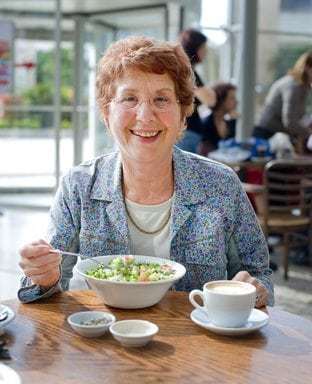Some say that once you reach your elderly years, you should be free to eat as you like. After all, why not fill your last days with your favorite foods and tasty treats? Want an extra slice of cake or two? Go for it! Crave cheesy pizza every night of the week? Why not? Want to ban vegetables from your diet entirely? That’s your prerogative! However, as wonderful as this free-for-all eating strategy sounds, it isn’t healthy and it won’t help you live a longer and happier life. In your golden years, you don’t need to maintain the strict diet of a young athlete, but you should certainly focus on eating a well-balanced and healthy diet. Not only will it help your body stay strong, but it will improve your energy level and help you maintain a healthy weight as well. If you aren’t sure where to start, check out our healthy eating tips for seniors for help.
Healthy Eating Tips for Seniors
Talk to your doctor. Your specific health concerns will guide your dietary plan, so discuss your body’s needs with your doctor. Do you have diabetes? How is your cholesterol? Do you have high blood pressure? Are you, like most people, concerned about your heart health? These factors should influence your culinary choices.
Emphasize vegetables and fruits. Just like when you were a kid, colorful vegetables and fruits should dominate your plate at mealtimes. If this tip makes you groan, take some time to explore the produce section of your grocery store. Maybe you hate brussel sprouts and broccoli, but you love roasted carrots and spinach salads. Make a list of your favorites and fill up your grocery basket.
Limit salt, sweets, soda, and red meat. Although you don’t have to avoid them completely, try to limit your intake of sugary sweets and red meat. Instead, purchase sweet fruits (which have natural sugars) and fish or poultry. Also, put down the salt shaker and beware of frozen meals and canned soups, which are often very heavy in sodium.
Go for whole grains, not simple carbs. Simple carbohydrates include white flour, refined sugar, and white rice, and while these foods are tasty, they don’t have the fiber and nutrients you need. Plus, they’re known to cause spikes in blood sugar levels. Instead of these bad carbs, look for complex carbs like whole grains that will keep you full and energized.
Follow the Age 50+ Guidelines from USDA Food Patterns. Want some specific, concrete advice? According to these helpful USDA guidelines, you should (based on your recommended calorie intake) enjoy 5-9 ounces of grains, 2-3.5 cups of vegetables, 1.5-2 cups of fruit, and 3 cups of dairy per day. You should also have 8-10 ounces of seafood, 24-31 ounces of meat, poultry, or eggs, and 4-5 ounces of nuts, seeds, and soy products per week. Finally, sugar and fat should be limited to 121-362 calories per day.
– – – – –
Healthy habits don’t have to be a struggle. Find the vegetables you most enjoy, make small changes at the start, and focus on how healthy food makes you feel. Good luck!
Looking for an assisted living facility in the Midwest? Be sure to check out Hearthside Senior Living Place. Each of our eight retirement communities includes a Health and Wellness program, fitness center, exercise classes, fun events and activities, and healthy food options. To learn more about the program and our commitment to healthy senior living, contact Hearthside Senior Living Place today.

